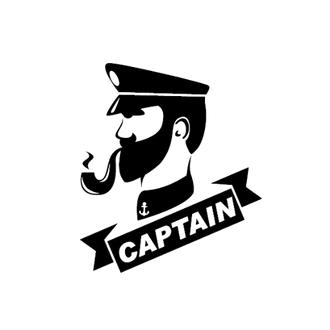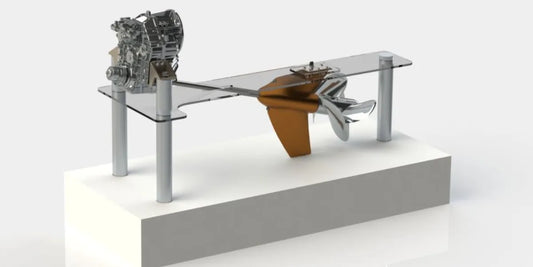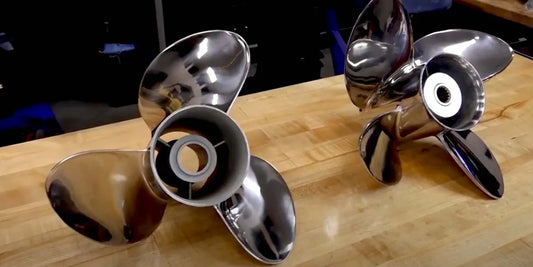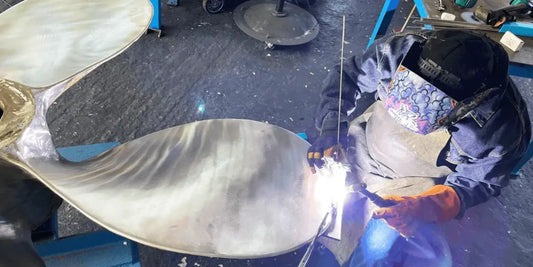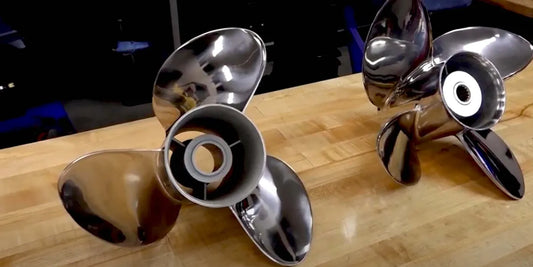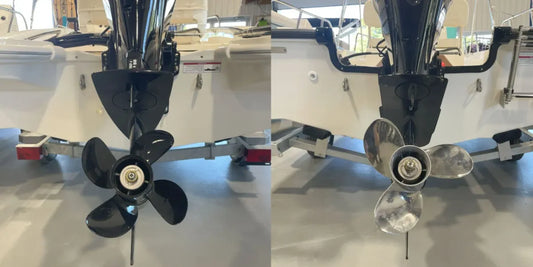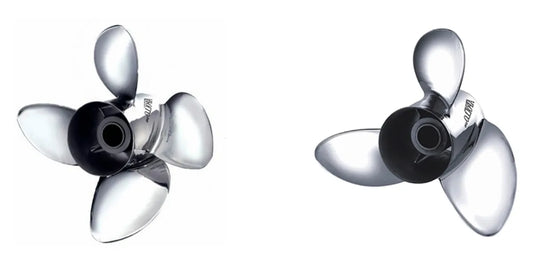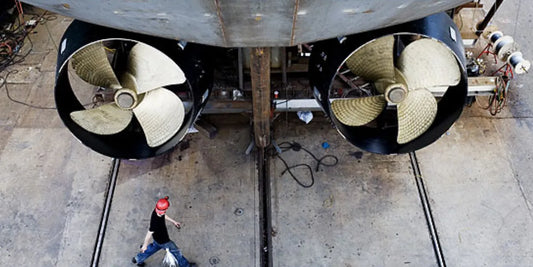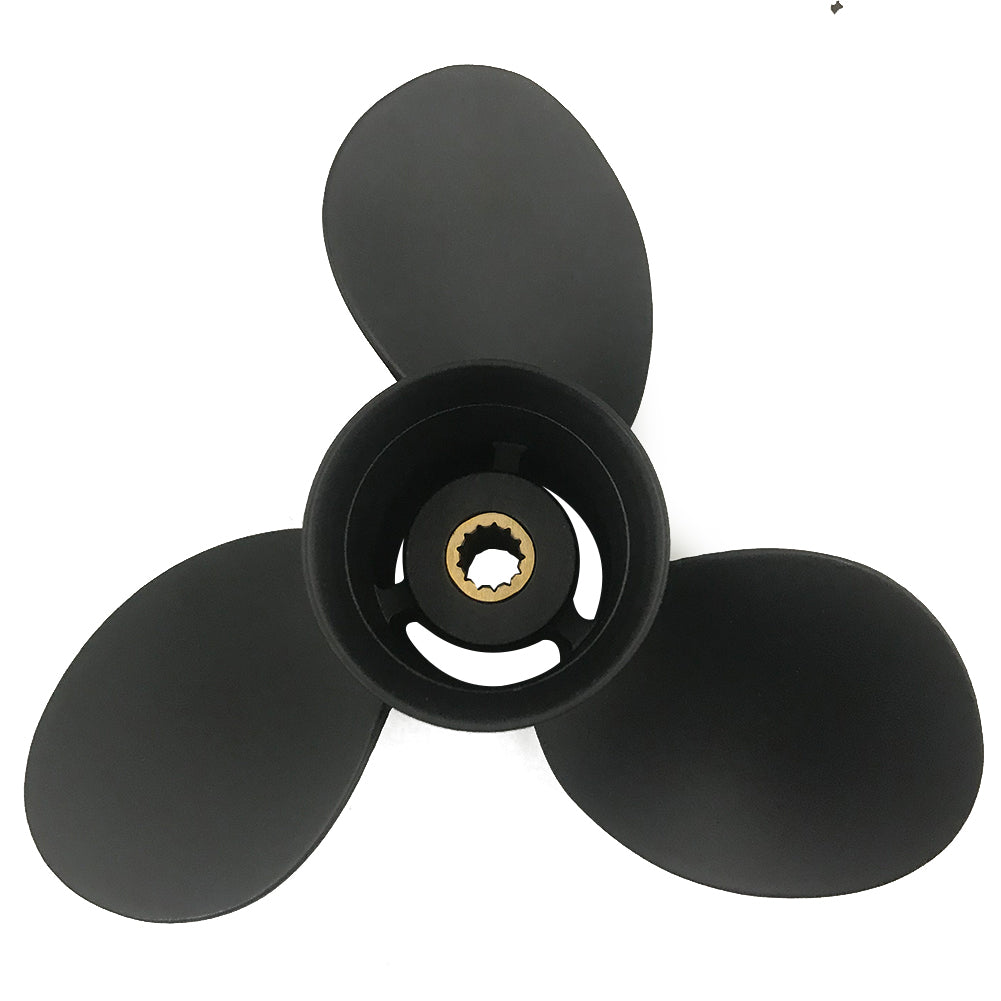Choosing a propeller for your boat generally comes down to choosing between aluminum or stainless steel. Every substance has benefits and disadvantages, varying based on performance requirements, budget, and operational scope. This article will highlight some differences between the two materials to determine which is best suited for your specific requirements. If you are looking for optimum performance, durability, or cost-effectiveness, knowing the attributes of the materials will help you make an informed decision while propelling your boat.
What are the Key Differences Between Aluminum and Stainless Steel Propellers?

How Does Each Propeller Material Affect Boat Performance?
Because of their material differences, aluminum and stainless steel propellers significantly affect boat performance.
Aluminum Propellers:
Cost and Efficiency: These props are inexpensive and proficient in leisure yachting and informal use.
Weight: Less, which can cause a bit more decrease in performance at high speed but gives reasonable thrust for middle-sized yachts.
Ideal Use: Recommendable for lower-powered yachts or those fitted with engines of less than 150 horsepower.
Durability: A softer and more malleable material that makes it prone to damage, wear, and tear from strikes or abrasions but is simpler and cheaper to fix.
Stainless Steel Propellers:
Weight: More compact owing to the denser material implies better power conversion and speeds.
Durability: Tough and damage-resistant, making it unfortunate for high-performance applications and heavy endurance.
Performance: A thinner profile with more significant details for complex but more efficient blades improves maneuverability for speed scaling.
Cost: This prop was initially expensive but economical and has dependable longevity.
Ideal Use: Best suited for extensive yachts, speed boats, and professional works with over 150 horsepower.
Regarding the technical information provided for the aluminum and stainless steel props, decisions based on their performance, financial allowance, and boating habits will be feasible.
What are the Durability Differences Between Aluminum and Stainless Steel?
Stainless steel wins durability against aluminum because of its superior strength and resistance to wear. Stainless steel propellers are robust and less prone to damage from impacts or debris in the water. This durability is a result of material properties, which include:
Tensile Strength: Compared to aluminum, stainless steel has far better tensile strength, which allows it to endure higher stress for a more extended period without succumbing to structural failure.
Corrosion Resistance: Aluminum can corrode or exhibit pitting without adequate maintenance or protective coverings, while stainless steel retains ample corrosion resistance in saltwater environments.
Weight and Flexibility: Though lighter, aluminum is more flexible and prone to deformation due to heavy load or impact forces, resulting in a loss of long-term durability.
While more affordable and suitable for lighter recreational, aluminum propellers do not outlast stainless steel propellers, which are better suited for professional use. The decision on which to choose depends on the balance of where, how frequently, and the initial spending limit.
How Does Propeller Pitch Vary Between Aluminum and Stainless Steel?
The concept of propeller pitch describes the distance a propeller would travel in one rotation under theoretical conditions with no slippage. Differences in the pitch of aluminum or stainless steel propellers stem from the material's strength and the overall design's accuracy.
Aluminum Propellers:
Therefore, these propellers are less stiff and can change pitch during higher loads or RPMs because of flexing within the structure.
Generally provide fixed pitches appropriate for regular recreational boating and less strenuous tasks.
Stainless Steel Propellers:
More excellent performance on stainless steel propellers. Consistency is maintained at higher loads or speeds due to stainless steel's rigidity.
Provide much greater flexibility in pitch range designed to enable specification for high-speed or heavy load applications.
To ensure maximum efficiency and optimal performance in differing conditions, these differences in pitch variance are crucial when choosing a propeller. Stainless steel propellers and their rigidity allow for more precision and dependability, unlike aluminum propellers, which are more suited for general use.
Why Choose Between Aluminum and Stainless Steel Propellers?

What Factors Should You Consider When Selecting a Propeller?
When choosing a propeller, my boat and its operational use are among my top priorities. First, I focus on the material: aluminum or stainless steel. Aluminum propellers are relatively cheap and adequate for general leisure use. However, their increased durability makes stainless steel propellers more efficient in high-speed or heavy-load scenarios.
Then, I assess the pitch and diameter of the propeller. A lower pitch improves my acceleration and towing capability, while a higher pitch increases top-end speed. The power and size of my engine determine the appropriate diameter for optimal use. Furthermore, the number and shape of the blades must also be considered—the speed-favoring three-blade prop is less stable than the more stable four-blade propeller.
Then, there is the choice of fixed-pitch or variable-pitch propeller. Fixed-pitch options can adequately serve most situations, but variable-pitch propellers provide better fuel economy and adaptability in rapidly changing load or speed conditions. After carefully considering all the factors, I can be sure that my boat will be able to serve me for a long time while performing to the best of its abilities.
How Does the Type of Boat Influence the Choice?
A specific boat type will dictate what kind of propeller is preferred for that boat because of the varying required functions and performance. A three-blade type is considered best for speedboats, as it gives preference to speed and acceleration. Meanwhile, bigger vessels like fishing boats or cruisers benefit from four-blade propellers since they provide better thrust at low speeds, stability, and smoother handling.
The technical characteristics with the highest degree of importance include, but are not limited to, the following:
Power and RPM: The size and pitch of the propeller must correlate with the power rating and the RPM of the engine's horsepower for the best performance without straining the engine.
Minimum operational and type of hull: Planing hulls faster boats, thus needing propellers aimed at speed, in contrast to displacement hulls, which focus on efficiency and steady speed, particularly under heavy-laden conditions.
Function: Propellers customized with lower pitches to increase pulling power are suitable for leisure boats. In comparison, heavy-duty working boats designed for towing may use higher pitches for faster speeds.
To optimize fuel usage and efficiency of the propeller and engine system, all of the parameters mentioned earlier must be carefully analyzed in terms of the application specific to the boat.
What is the Difference Between Aluminum and Stainless in Terms of Cost and Maintenance?
Aluminum and stainless-steel propellers differ significantly at cost and maintenance levels, each serving specific needs and conditions.
Cost:
Aluminum propellers are much cheaper, which is advantageous for casual boaters or people with limited budgets.
Stainless steel propellers cost more as they are much stronger and more durable than aluminum. Also, performance-driven users are likely to appreciate it more for its structural strength and capabilities.
Maintenance:
Aluminum propellers tend to get damaged by bending and chipping when coming in contact with debris or rigid objects. While repairs tend to be more straightforward and inexpensive, their longevity is questionable.
Stainless steel propellers can withstand impacts and corrosion much more than aluminum, allowing them to be repaired or replaced infrequently. However, the cost of repairs for more severe damage will be much higher than aluminum, which can make stainless-steel propellers more expensive.
Consideration of the operating environment, performance expectations, and budget will shape the choice of the material. For instance, aluminum works better with freshwater and lower speeds, while harsher marine conditions and high-performance stainless steel work much better.
How Does Propeller Blade Design Impact Performance?

What Role Does the Number of Blades Play?
In simpler terms, the number of blades on a propeller determines how fast it can go, the process it uses to go, and how much noise it emits. Generally, blades in the range of two to three tend to be more suited for top-speed efficiency than 4-5 bladed propellers. Therefore, they are optimal for fast-moving assists. More blades are also suitable for obtaining thrust; consequently, they are preferable for higher torque and thrust-pertaining boats. In addition, fewer blades mean less noise and vibration emitted by the vessel, causing optimal operational silence.
Efficiency - Reducing the number of blades decreases drag, therefore even minimal increase in speeds results in more effective - operational thrust.
Cavitation Resistance - Imposing more bladed propellers helped with cavitation with high load conditions due to it causing equal distribution of pressure.
Thrust—Blade propellers with more than three blades have the added advantage of increased thrust, which is more pronounced at lower speeds.
Smoothness - Propellers with more than three blades cause smoother operational transitions due to emitting less vibration.
Noise: Multi-blade vessels emit lower noise, enabling their use in sensitive operational environments where noise is not desired.
The best number of blades depends on the conditions under which the vessel will operate, its nature, and other performance objectives.
How Do Thinner Blades Affect Speed and Efficiency?
The use of thinner blades, in particular, can have a heavy impact on the process's speed and efficiency. The following constructs mainly dictate their effects:
Reduced Drag: Cuts in energy consumption are experienced because the propulsion tends to be in a forward direction. Blades with lesser width tend to lessen the drag, enabling more incredible cutting speeds within water or air. This enhanced speed is especially needed in situations requiring speed in movement.
Improved Hydrodynamic and Aerodynamic Performance: Thinner blades reduce resistance because of their streamlined design, enhancing overall efficiency. Blades that are thinner in breadth perform more blades more efficiently in areas where energy expenditure needs to be curtailed.
Cavitation Resistance: Blades with a lesser width increase the chances of cavitation, especially at high speeds or heavy loads. Material strength and accurate structure are crucial to prevent this situation.
Load Distribution: Thinner blades improve speed by lowering the load-bearing capacity these blades offer, but they tend to be less valuable when dealing with high-torque applications.
Depending on the use intention and conditions under which one operates, balancing and assessing speed combined with efficiency and durability can be used and addressed later.
When should you go with stainless steel propellers for your boat?

What are the Advantages of Stainless Steel Propellers?
Durability and Strength—Stainless steel propellers cope much better than aluminum ones. Stainless steel is stronger and more resistant to impacts or debris than aluminum. Its excellent durability makes it well-suited to rough or shallow environments.
Improved Performance—Due to less flex and proprietary shape retention during high stress, stainless steel propellers enhance performance. They enable improved acceleration, speed, and efficiency due to consistent hydrodynamic performance.
Corrosion Resistance – Styl steel has superior corrosion resistance, particularly in saltwater, resulting in a longer lifespan and reduced maintenance requirements.
Design Precision—The blades' finer drag further enhances water flow dynamics, performance, and speed, while the strength of the stainless steel allows for a thinner and more precise design.
Enhanced Load Capacity—While still efficiently supporting heavy-duty or high-performance engines, stainless steel propellers with an increased strength-to-weight ratio set a new standard for sustaining high torque and outperforming delivered power.
Propeller design is truly an engineering marvel when all is said and done. As with stainless steel propellers, it’s a fantastic feat; other parameters, like the boat's weight, operational environment, and engine power, become optimally controllable to achieve the set target.
In What Situations Does Stainless Steel Provide Better Performance?
Stainless steel is optimal in situations where performance and durability are key factors. For example, operating my boat in rough waters or heavily debris-filled areas means that stainless steel's higher strengths and impact-resistant features enable propellers to endure difficult conditions without damage. Also, in high-performance propulsion systems where maximum speed and precision are required, stainless steel improves acceleration and top-end performance because the material's design drag is lowered due to optimum water flow dynamics.
Material Strength: Superior resistance to damage and wear from impact or friction compared to aluminum.
Load Capacity: Permits higher output torque and power needed for heavy-duty engines.
Hydrodynamic Efficiency: Allows more thinning for better water dynamics.
Corrosion Resistance: Highly durable in saltwater or harsh environments for extended periods.
These features make stainless steel the best candidate for intense boating conditions or when a vessel's performance is considered.
How Does the Stainless Steel Prop Affect Fuel Economy?
As far as I know, stainless steel props can significantly improve fuel economy under the appropriate conditions. Their insulative strength and increased hydrodynamic efficiency guarantee more precise and thinner propeller blades. These blades can augment propulsion, reduce drag, and optimize the water flow, which, in turn, requires less effort from the engine. This suggests the engine will use lower RPMs for a particular speed, hence conserving fuel.
Stainless Steel Prop enables Hydrodynamic Efficiency: The streamlined design ensures less fuel is used to overcome drag and associated energy loss during propulsion.
Material Strength: Stainless steel's robust nature prevents deformation under high torque, ensuring fuel efficiency and performance over prolonged periods.
Corrosion Resistance: Sustained saltwater exposure and wear and tear ensure that the propeller drastically reduces efficiency loss and performance deterioration through frequent replacements.
Considering all these factors, it is shared that props made from stainless steel provide better performance for fuel efficiency when matched to the proper engine specifications.
When is an Aluminum Propeller the Better Choice?

What are the Benefits of Using an Aluminum Propeller?
Aluminum propellers have advantages, especially in public usage, where cost-benefit analyses must be presented. First, aluminum props are far cheaper than stainless steel ones, which are more suited for people with deeper pockets. Their lower weight also helps ease the burden on the engine while operating, which helps iron out the differences.
On the engineering end, aluminum propellers can be adequate for the performance of smaller vessels or engines used in waterways that gently slope. While not as durable as stainless steel, aluminum is sufficiently light-duty and repairable if damaged, which is the best of both worlds.
Material Strength: Regarding aluminum, the same argument can also be made because it lacks the strength of stainless steel. The only change to be made is that I'm now outputting for higher-end boats that endure a rough time in the waters.
Corrosion Resistance: Assuming adequate coating is withstanding, corrosive-resistant aluminum can sometimes aid but lacks attention to saltwater devoid of extra guarding.
Hydrodynamic Efficiency: Although prohibited by the rule of efficiency, an aluminum propeller can reasonably serve in adequate circumstances with less fuel spent fuel for more aloft economy crafts.
In summary, casual and seasonal sailors are looking to take advantage of the waterways in their leisure time without pushing towards finding the best out of practicality and costs with set aluminum propellers.
How Does Aluminum Affect Top Speed and Acceleration?
Compared to stainless steel, aluminum propellers have lower material strength and hydrodynamic efficiency, which affects top speed and acceleration. In my experience, aluminum props tend to yield lower top-end speeds because, at elevated RPMs, they have a greater tendency to flex, which can reduce thrust. While decent, acceleration may also be moderately diminished because of the lighter, less rigid aluminum props’ power transfer efficiency.
Material Strength: In this case, aluminum's flexibility can reduce efficiency at higher speeds, slightly reducing top speed.
Hydrodynamic Efficiency: The propeller’s attenuation of efficiency affecting acceleration and forwarding speed is modest due to aluminum’s lower efficiency than stainless steel, which is still more than acceptable for general application.
Durability Under Load: Soft aluminum may meet moderate performance standards under load but will fall short of maintaining peak performance against more rigid materials under harsh conditions.
Anyway, aluminum propellers are still a reasonable compromise to consider for unrestricted and non-extreme recreational boating cases.
Why Might Aluminum Props Be Ideal for Shallow Water?
Unlike conventional materials, aluminum is ideal for low water depth regions because of its lightweight and economic features, making it easier to replace if damaged due to bumps against submerged rocks or debris. These materials will undergo plastic deformation while deflecting trace energies, thus preventing damage to crucial components like the drive shaft. Furthermore, the softening of aluminum gives it a protective role in harsh environments and decreases the immediate load on the engine.
Durability Under Load: Aluminum has lower endurance than harsher metals like stainless steel in most scenarios, but it is more ideal in shallow waters.
Material Strength: Although more flexibility means lower efficiency, it can prevent power losses from collisions with the bottom in shallow waters.
Cost Efficiency: Equitable for recreation or utility boating, aluminum props frequently visit shallow regions where prop replacement is usually needed.
Aluminum props are the most practical, reliable, and cost-effective option when dealing with low water depth regions.
Frequently Asked Questions (FAQs)
Q: What difference do aluminum props and stainless steel props have?
A: There are many differences between the two variables, including cost, performance, and flexibility. Aluminum props are cheaper, gentler on passed obstacles, and lighter than stainless steel props; however, they do not have the capacity of stainless steel props. Stainless steel props are more costly and challenging, standing strong under a boat's impact, meaning they can withstand greater loads because they are more potent in construction and support and lower the boat unit while being more forgiving towards damage.
Q: What impact does the material of props have on performance?
A: Material dramatically affects the performance, especially the propeller. According to facts, stainless steel propelers allow smoother acceleration while boasting an extraordinary top speed. Aluminum offers an excellent performance; it is undoubtedly more malleable in terms of flexibility compared to stainless steel, loosening the grip of power/bite, efficiency, and top speed of the boat—both types of handling and the time needed to come out of water.
Q: Can I get Michigan Wheel propellers in both aluminum and stainless steel materials?
A: Michigan Wheel propellers are available in aluminum and stainless steel. They offer various prop options for different boating needs. Boaters can select aluminum or stainless steel props depending on their requirements, type of vessel, and performance expectations.
Q: How do aluminum and stainless steel props compare regarding wear and tear?
A: The pros of stainless steel props include that they are more durable than aluminum ones and can bear more significant impacts without the risk of bending or deforming. While not as durable, aluminum props are gentler on obstacles and easier to repair. Deciding between aluminum and stainless steel props usually comes down to the wear and tear in the boating area and how often you sail over underwater obstacles.
Q: Which prop material is better for higher horsepower outboard motors?
A: Why use anything other than stainless steel for higher horsepower outboard motors? They are the most efficient and can take on all added power and torque without flexing with such outboards. Unlike other materials, stainless steel props have almost no deformation at high RPMs. The benefits of this feature include enhanced prop bite and faster top speeds. That said, high-grade aluminum openers can also be used on some powerful motors but are not preferred.
Q: How does choosing aluminum and stainless steel props affect fuel efficiency?
A: A few factors influence fuel economy, including props and their material builds. Stainless steel props will always have the edge on fuel efficiency due to their rigidity and ability to maintain shape under stress. There is much less energy loss and smoother energy transfer into water. Still, aluminum props can add flex, affecting efficiency, especially on more powerful motors.
Q: Should I carry a backup prop, and if so, what material should I use?
A: Sure, carrying between one and three spare props, primarily for longer trips, and if you're close to unfamiliar waters, can always help. Most boaters will even have an aluminum prop as a spare, even though they usually use stainless steel. This is particularly true for them, as stainless steel props are considered pricier. Getting an aluminum prop as a spare is more economical. They're easier to break, thus reducing the risk of harm to the lower unit. Still, the optimal selection to be used as a spare prop depends on the boat type you have and your preference.
Q: What is the cost difference between an aluminum and a stainless steel prop?
A: Stainless props, in most situations, will, at a minimum, cost two to three times more than aluminum props. While the difference in cost certainly stays within that bandwidth, props of stainless steel are usually accepted when compared to their aluminum alternatives, especially in their ability to withstand proportionally much higher amounts of value coming from a boat and overall maintain the performance and structure of props. This is a reasonable motivation for many boaters, and their initial reason depends on their long-term gain overhead for the initial price paid. It’s generally a simple situation of balancing the primary clear-cut spending versus the sustainable reliability performance over the durable factor.
